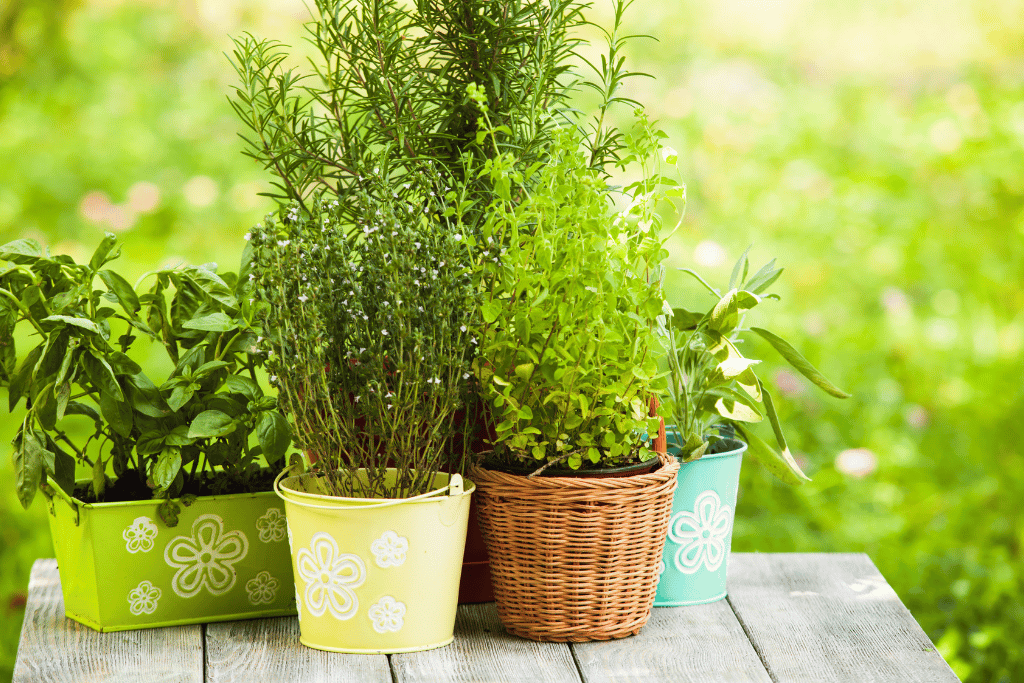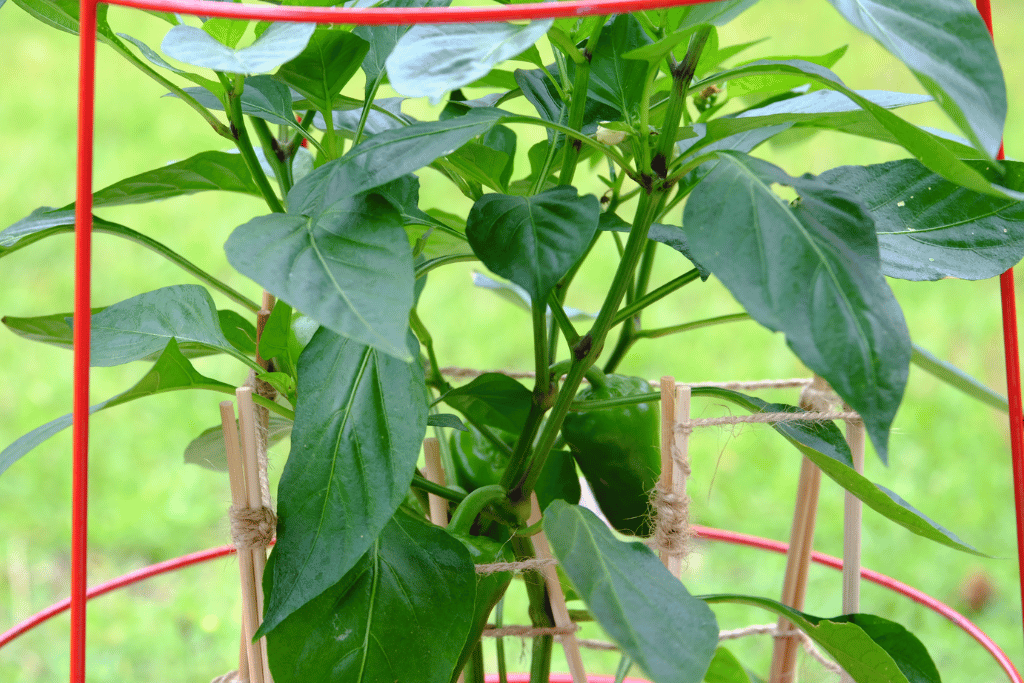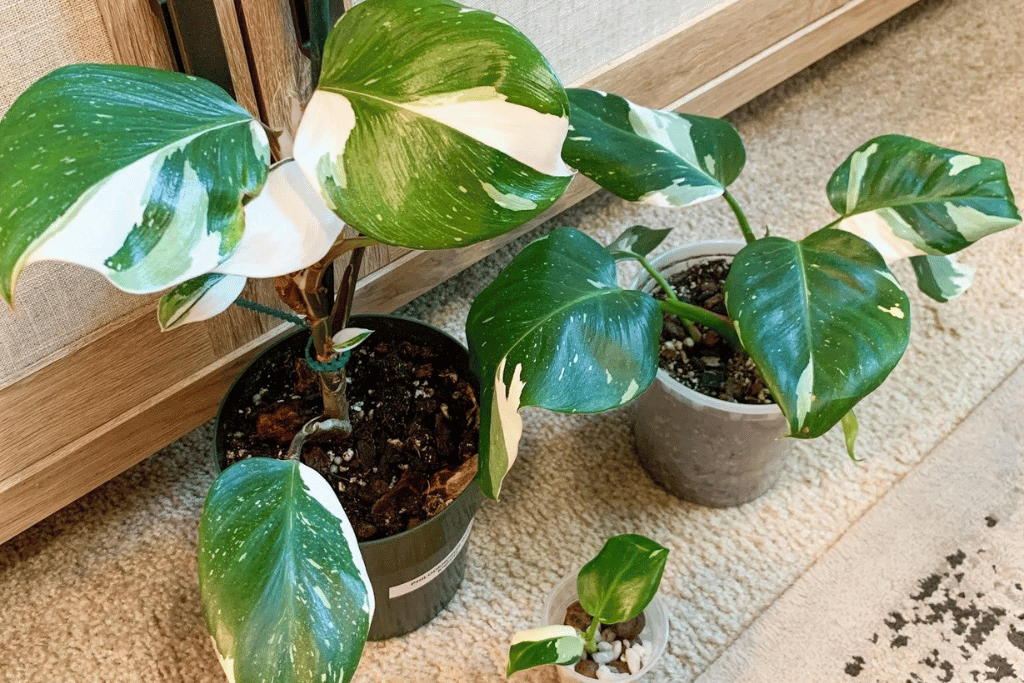
As someone with a deep-rooted passion for plants (no pun intended), I’ve spent countless hours exploring the world of philodendrons. A recent fascination in my horticultural journey are the elusive members of this family – the Philodendron White Knight and the Philodendron White Wizard. Why not have a Philodendron White Knight Vs White Wizard comparison?
Do you know why the White Knight and White Wizard philodendrons are so special? Well, it’s because they look similar to each other but have subtle differences that set them apart from other plants. It’s almost like a game of “spot the difference”! By understanding these small variations, you can decide which type of philodendron is right for your home or office.
After careful examination, I found that the White Knight and White Wizard philodendron stems have distinct widths. The stem of the White Knight is usually thicker than the stem of the White Wizard. In addition, there are differences between their leaves, color, growth rate, size and more.
One interesting fact about these two types of philodendrons is that they both bloom in the springtime.
So now you know – the White Knight and White Wizard philodendrons are two unique types of plants with interesting differences. Pretty cool, right? If you want to know more about these two philodendron varieties? All you need to do is keep reading..
The Shared History of White Wizard and Philodendron White Knight
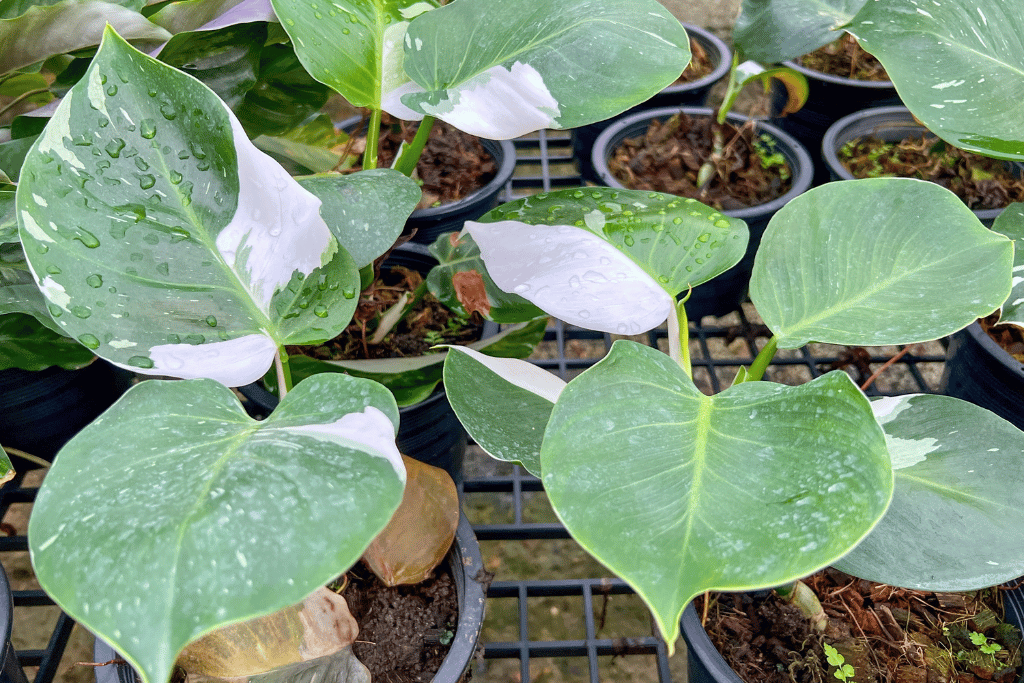
Learning about plants is like following a treasure map full of secrets. Even though we don’t have all the answers, we do know that the White Wizard and Philodendron White Knight are related and come from the same plant family, called Araceae. These special plants have their origins in South America, a faraway place where they’ve been growing for a long time.
Starting in South America: A Green Mystery
Imagine a far-off land filled with jungles and warm weather – that’s where the White Wizard and Philodendron White Knight come from. While we don’t know all the details, we’re sure these plants started their journey in South America. The warm and tropical climate there helped them grow and develop into the plants we love today.
Cracking the Code of Variegation
One of the coolest things about the White Wizard and Philodendron White Knight is their fancy coloring, with those spots of white on their leaves. This color change happens for a few different reasons:
Viral Changes: Sometimes, plants get sick from viruses. This can make their leaves change color as a response to the sickness.
Random Changes: Nature loves surprises, and sometimes plants change their look for no reason at all. It’s like having different puzzle pieces in their leaves.
Passing Down Color: Just like you inherit things from your family, plants can inherit colors from their parents. These philodendrons might get their special look from their plant parents.
Climbing Up High: A Different Way
Imagine if you liked climbing trees to see the world from up high. Well, the White Wizard and Philodendron White Knight feel the same way—they like to climb. Unlike the White Princess philodendron that stands alone, these two like to reach up towards the sun. It’s like they’re trying to touch the sky!
Sticking Around for a While: Perennial Pals
The White Wizard and Philodendron White Knight aren’t just temporary visitors. They’re what we call perennials, which means they’re around for a long time. Instead of growing and disappearing in one year, these plants stick around to be your friends for many years.
Embracing the Mystery
As we go on this journey into the history of the White Wizard and Philodendron White Knight, we’re like explorers in a world full of secrets. Even though we don’t know everything, we do know that these plants have a colorful past from South America, a story of changing colors, a love for climbing, and a promise to stay with you for a long time.
Taking care of them means joining their adventure and adding your own special chapter to the story of amazing plants.
Exploring the Notable Differences: Philodendron White Knight Vs White Wizard Houseplants
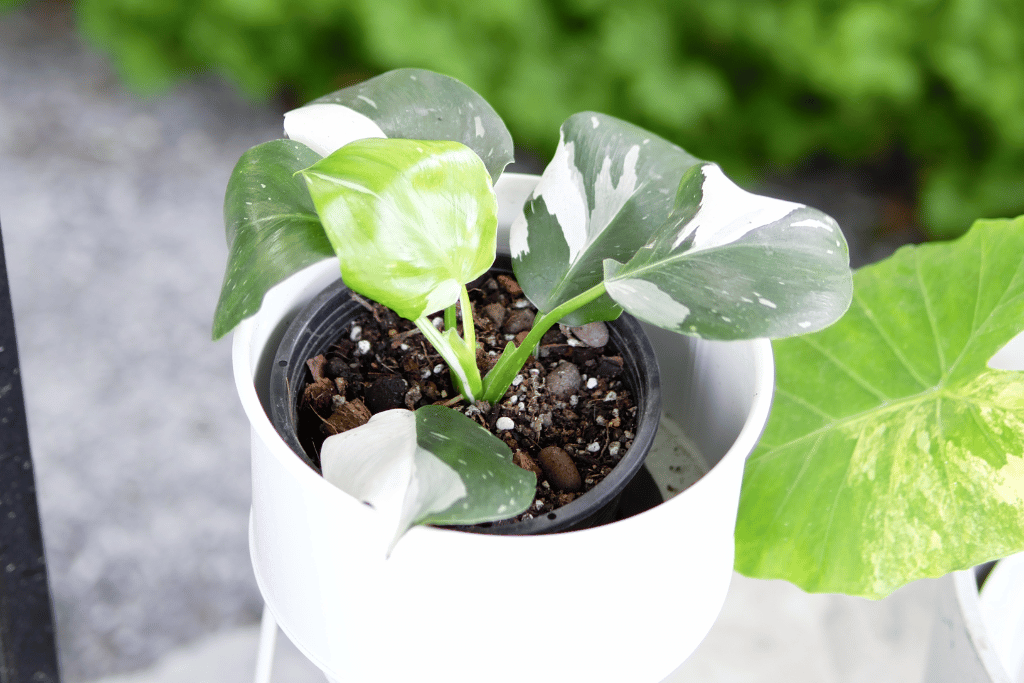
| Feature | Philodendron White Knight | Philodendron White Wizard |
| Stem Width | Thicker | Thinner |
| Height | 8-10 feet | Taller potential growth |
| Petiole Color | Brown with occasional purple streaks and white patterns | Vibrant green |
| Leaf Color | Green and white | More extensive white variegation with deep green |
| Leaf Size | Smaller | Larger and elongated |
| Leaf Shape | Rounded to cordate (heart-shaped) | Lanceolate and ovate |
| Stem Color | Brown | Dark green |
| Light Requirements | Medium light, indirect sunlight | Sensitive to direct sunlight, give indirect sunlight |
| Watering | Allow top 2 inches of soil to dry between watering (once a week) | Allow top 2 inches of soil to dry between watering (once a week) |
| Humidity | Prefers high humidity, use pebble trays or misting (50% – 75%) | Prefers high humidity, use pebble trays or misting (50% – 75%) |
| Temperature | 65-75°F (18-26°C) | 65-75°F (18-26°C) |
If you’ve ever found yourself wondering about the distinct features that set apart the delightful philodendron White Knight from the elegant White Wizard, you’re not alone. These lush indoor plants each possess a unique charm, and by digging into their individual characteristics, we can better appreciate what makes each of them so special.
Variations in Plant Height
When it comes to the matter of height, the philodendron White Knight tends to maintain a relatively modest stature, typically reaching an ultimate height of around 8 to 10 feet.
On the other hand, its counterpart, the White Wizard, holds the potential for reaching even greater heights. In fact, the White Wizard can grow to be so towering that it easily surpasses the size of its White Knight counterpart.
To put it into more relatable terms, this difference in height is akin to comparing winning an esteemed Olympic Gold medal to securing a respectable Silver. By visualizing the impressive growth of these plants, we can truly appreciate the substantial difference in their vertical presence.
Leaf Traits
Upon closer examination of the leaves, we can uncover several noteworthy features that set these two plants apart:
Distinctive Petioles
The petiole, which is the stem connecting the leaf to the main plant, serves as the first point of distinction. In the case of the philodendron White Knight, its petiole displays an intriguing palette of brown hues, occasionally accompanied by subtle streaks of purple.
The delicate white patterns can be observed on occasion, providing a touch of elegance.
Furthermore, the petiole of the philodendron White Wizard maintains a consistent and vibrant green color throughout its length. This striking difference in petiole coloration offers a clear visual indicator to discern between these two plants.
Leaf Colors
The leaf colors of the philodendron White Knight present a harmonious blend of green and white. The leaves showcase a delicate interplay between these two hues, with patches of white artfully scattered against a backdrop of varying shades of light to dark green.
In contrast, the leaves of the White Wizard take on a bolder appearance, with an even more pronounced expanse of white variegation. This extensive white pattern is beautifully complemented by a deep, rich shade of green, creating a visually captivating effect that is distinctly different from the White Knight.
Leaf Sizes
Leaf size plays a substantial role in distinguishing these two plants. The leaves of the philodendron White Knight tend to be smaller in size, maintaining a charming compactness.
While the White Wizard boasts leaves that are significantly larger and more elongated. This difference in leaf size not only contributes to the overall appearance of each plant but also imparts a majestic quality to the White Wizard’s aesthetic appeal.
Leaf Shapes
The shapes of the leaves offer yet another dimension of contrast between these two plants. The philodendron White Knight features leaves with a rounded to cordate shape, reminiscent of a heart. This unique leaf shape adds an element of warmth and charm to the plant’s overall presentation.
Conversely, the philodendron White Wizard presents a different leaf shape, characterized by its lanceolate leaves and ovate silhouette. This elongated and slender leaf shape imparts an air of sophistication and elegance to the White Wizard.
Discerning Stems
Even the stems of these plants exhibit distinctive features that aid in their differentiation. The stems of the philodendron White Knight are characterized by their brown coloration, lending them a grounded and rustic quality.
These stems also appear to be broader in comparison to the dark green stems of the White Wizard. The stems of the White Wizard, with their deep green hue, provide a sense of vibrancy and vigor that complements the plant’s overall appearance.
What’s the Verdict?
When faced with the delightful decision of choosing between the philodendron White Knight and the White Wizard, it’s essential to remember that the subtle nuances in leaf petiole colors, leaf sizes and shapes, and stem characteristics can all serve as valuable indicators for distinguishing between these two captivating houseplants.
By carefully considering these distinctions, you’ll be better equipped to make an informed choice that aligns with your preferences and the aesthetics you desire in your indoor plant companions. Here’s to an enjoyable and enlightening plant-shopping experience as you explore the unique world of these charming botanical wonders!
Similarities Between Philodendron White Knight and White Wizard Plants
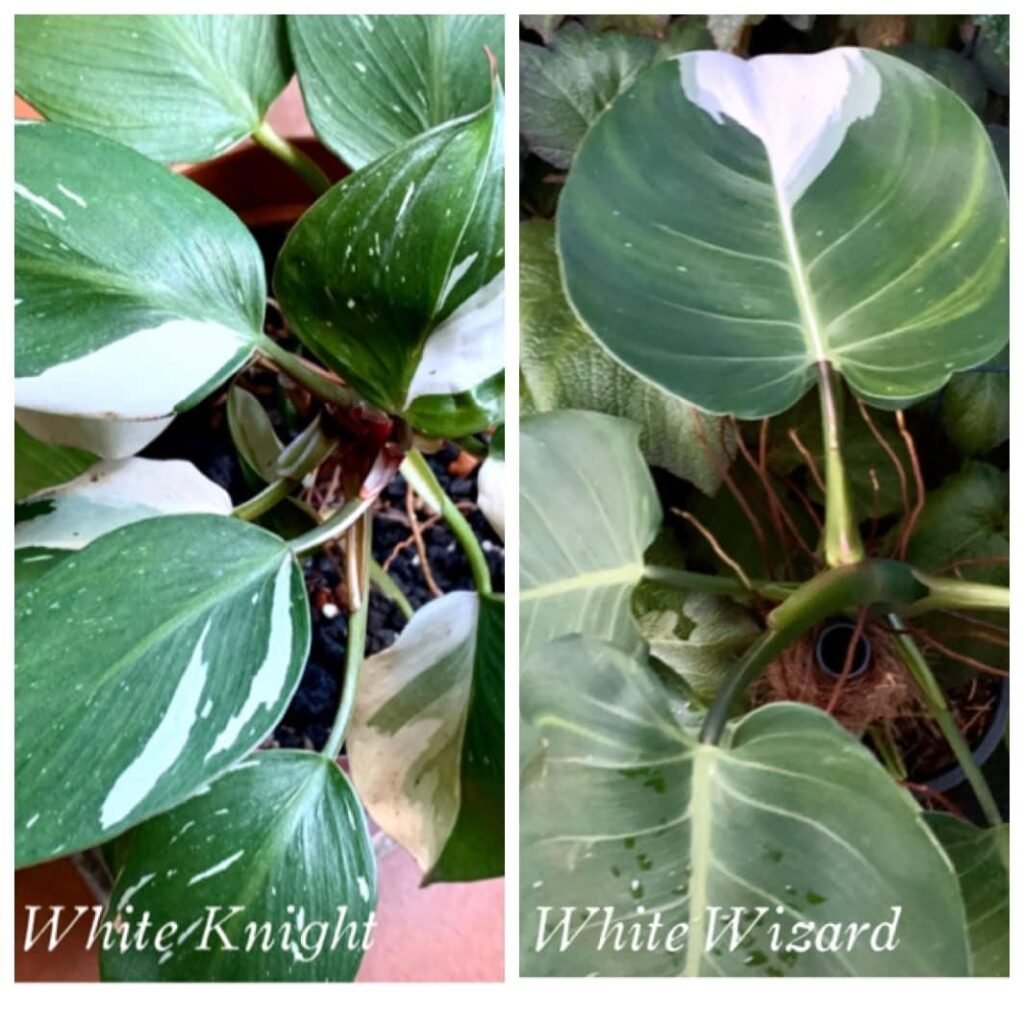
When it comes to understanding plants like the philodendron white knight and white wizard, it’s not just about the differences that set them apart, but also the common traits that bring them together. By recognizing these shared characteristics, we can enhance our appreciation and knowledge of these remarkable plants.
Plant Traits and Characteristics
Both the philodendron white knight and white wizard belong to a group of plants known as tropical perennials. This means they are plants that live for more than two years and thrive in warm, tropical environments.
Interestingly, despite their tropical origins, these plants have a surprising ability to withstand colder temperatures, which makes them suitable choices for indoor cultivation. However, it’s important to note that if you live in a place with a temperate climate, a little extra care might be necessary to protect them from the chilly weather.
The Art of Climbing
One captivating trait that both the philodendron white knight and white wizard share is their climbing nature. This climbing behavior is a common thread that unites them, even though their stem colors might differ. With the right support in place, these plants can gracefully climb and flourish, fully embracing their natural inclination to reach for the heights. It’s a fascinating sight to witness as they make their way upwards, adding a touch of green elegance to their surroundings.
Blossoms that Bind
While the lush foliage is undoubtedly the main attraction of these plants, there’s yet another aspect that brings the philodendron white knight and white wizard together – their blossoms. These plants, primarily known for their stunning leaves, occasionally surprise us with the appearance of delicate white blooms.
It’s a heartwarming sight to see these similar flowers gracing the plants, acting as a lovely reminder of their shared botanical heritage. The fact that they both produce these identical white blooms showcases their deep connection and botanical kinship.
All in all, in the world of plants, every species has its own unique characteristics that make it special. However, it’s equally important to acknowledge the commonalities that exist among different species. The philodendron white knight and white wizard, despite their differences, share certain traits that tie them together.
Their ability to thrive as tropical perennials, their natural climbing tendencies, and their occasional bursts of white blossoms all contribute to their shared narrative.
As plant enthusiasts and nature admirers, we can gain a richer understanding of these plants by exploring both their differences and similarities.
By doing so, we not only deepen our knowledge but also cultivate a greater appreciation for the intricate beauty of the natural world. So, the next time you come across a philodendron white knight or a white wizard, take a moment to marvel at the unique features that make them special, as well as the shared traits that unite them
The Advantages of Philodendron White Knight and White Wizard Plants
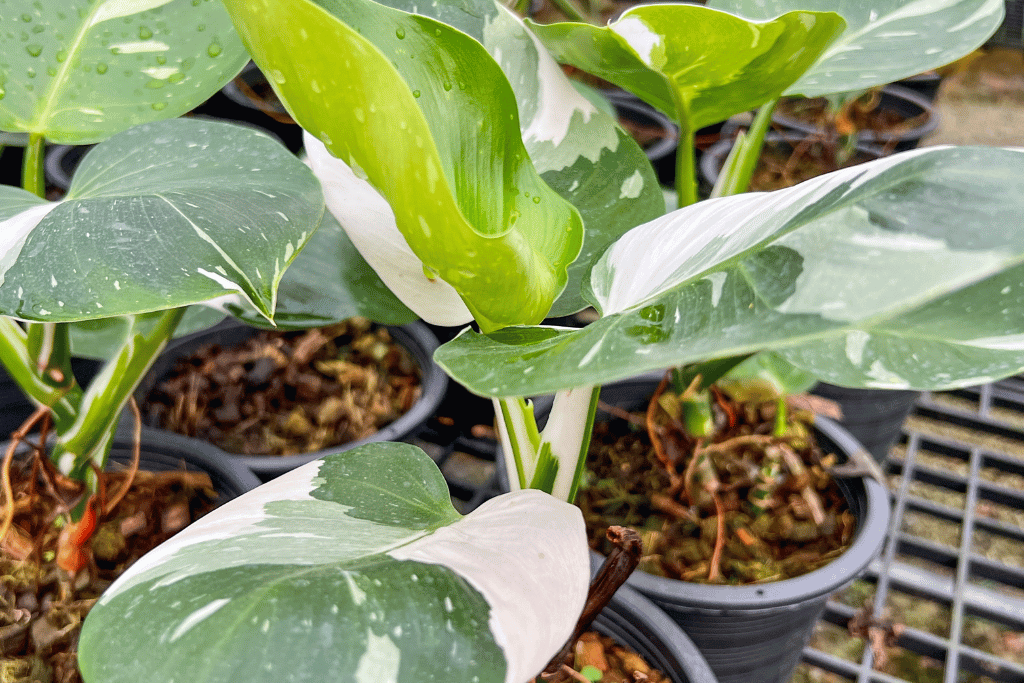
The remarkable benefits of these plants go beyond mere visual enhancement, encompassing various aspects that contribute to the overall well-being of an environment.
Elevating Aesthetics
The undeniable beauty of both the philodendron white knight and white wizard plants lies in their ability to elevate the aesthetic appeal of any space they inhabit. Acting as exquisite ornaments, these plants effortlessly infuse an air of sophistication into their surroundings, adding a touch of elegance that catches the eye and warms the heart.
Simplicity in Care
One of the most commendable attributes of these plants is their resilience and adaptability, qualities that make them exceptionally low-maintenance choices. Whether you are a seasoned plant enthusiast with a green thumb or a newcomer taking your first steps into the world of plants, the philodendron white knight and white wizard plants are companions that require minimal effort to thrive.
This simplicity in care doesn’t just make them hassle-free additions to your space; it also ensures that they remain vibrant and flourishing, delighting the beholder with their evergreen charm.
Enriching Indoor Ambiance
As inhabitants of indoor spaces, these plants hold the power to enrich the ambiance of their surroundings in remarkable ways. Their presence brings forth a sense of vibrancy and vitality that can transform a mundane environment into one teeming with life and energy.
Furthermore, these plants contribute to the purification of the air, actively working to create an atmosphere that is not only visually pleasing but also healthful to those who reside within it.
Generous Oxygen Producers
Both the philodendron white knight and white wizard plants exhibit a generous propensity to release oxygen into their surroundings. This remarkable trait plays a pivotal role in improving the overall quality of indoor air.
By augmenting oxygen levels, these plants align with the noble objective of fashioning living spaces that prioritize health and well-being, offering an infusion of freshness that invigorates the senses.
Promoting Serenity and Alleviating Stress
The benefits of these plants extend beyond the realms of aesthetics and function. Their mere presence within a space can have a calming and soothing influence, fostering an environment that is conducive to relaxation, tranquility, and peace. This unique quality of the philodendron white knight and white wizard plants contributes to an overall sense of well-being, creating an environment that supports restful sleep, stress relief, and a respite from the demands of daily life.
Making the Right Choice: Philodendron White Knight Vs White Wizard
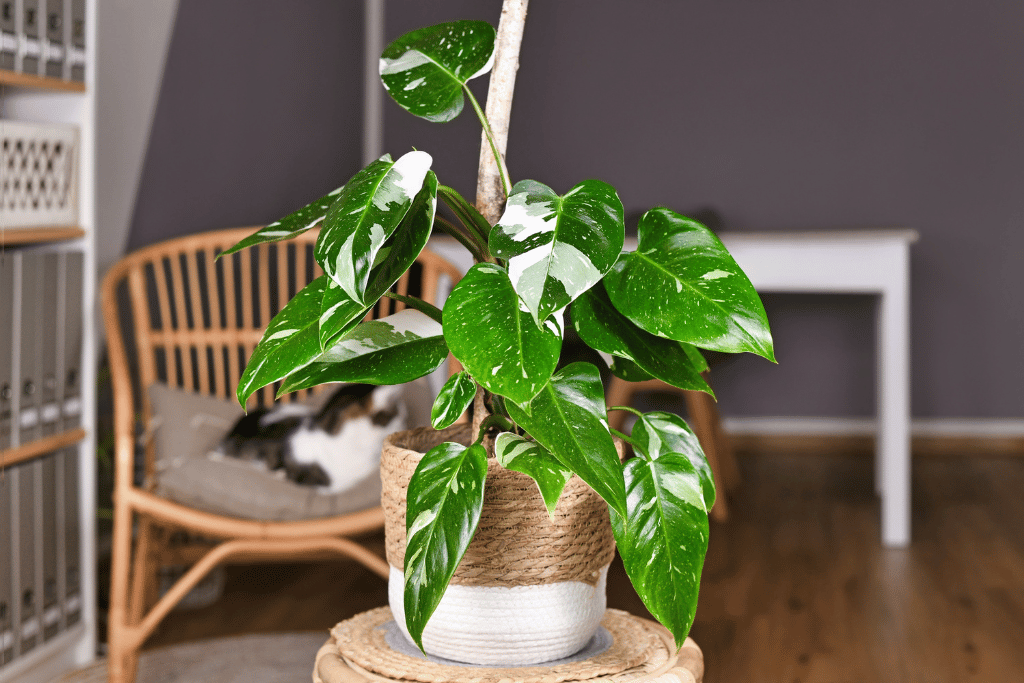
While both the philodendron white knight and white wizard plants possess their own captivating allure, specific considerations can aid in guiding your choice between the two.
Ease of Identification
In terms of ease of recognition, the white knight plant takes the lead due to its distinctive features. Its appearance sets it apart, making it easily distinguishable from other plants. However, it’s important to note that the white wizard plant’s resemblance to another cultivar, the philodendron white princess, can sometimes lead to confusion for those less familiar with these plants.
Insights into Availability
When it comes to availability, the philodendron white knight often enjoys a more consistent and widespread presence in the market. This ubiquity makes it a convenient choice for those seeking to acquire one. Conversely, the white wizard plant’s rarity might necessitate resorting to online sources or specialty nurseries for procurement, adding an element of exclusivity to its acquisition.
Monetary Factors
The uniqueness and scarcity of the white wizard plant contribute to its higher price point when compared to its counterpart, the white knight. Budget considerations may factor into your decision-making process, as the white wizard plant typically comes with a price tag that is approximately $15 to $20 higher than that of the white knight plant.
Aesthetic Considerations
Going deeper into aesthetics, the white wizard plant emerges as the distinctive choice due to its remarkable variegation. The intricate patterns and play of colors on its leaves make it a visual spectacle that draws the eye and captures the imagination. However, it is important to acknowledge the inherent charm of the white knight plant, which possesses its own unique beauty that appeals to different sensibilities.
So, What’s the Favorite Choice Between Philodendron White Knight Vs White Wizard?
Taking all these factors into account, the philodendron white knight emerges as a favored choice for many. Its ease of identification, availability, and relatively more accessible price point contribute to its popularity. However, the ultimate decision rests in your hands, influenced by your personal preferences, the specific ambiance you wish to create, and the resources you are willing to invest.
Whether you opt for the timeless elegance of the white knight or the captivating allure of the white wizard, both plants are sure to bring joy, beauty, and vitality to your space, enriching your environment in more ways than one.
White Wizard Vs Philodendron White Knight Care Comparison Guide
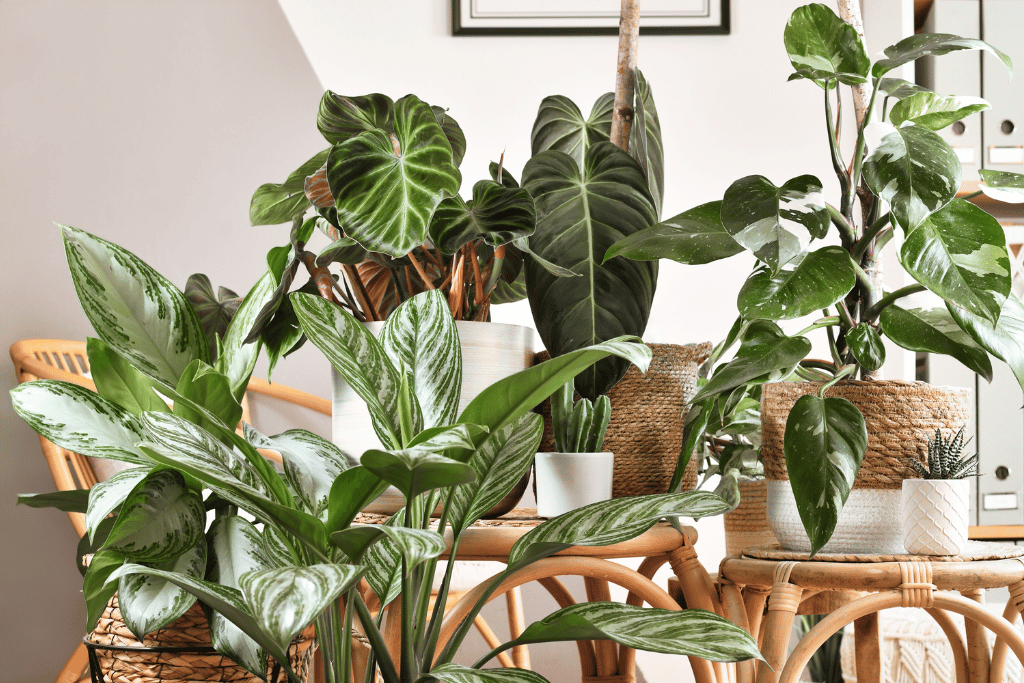
Philodendrons are wonderful plants that can bring a touch of nature’s beauty into your home. Two special types of philodendrons, the White Wizard and the Philodendron White Knight, might seem similar at first, but they have their own unique needs when it comes to taking care of them. Let’s explore their care requirements step by step to make sure your plants thrive!
Light Requirements
Imagine if you had to live in a place that was too bright or too dark for you. Plants feel the same way about light! The White Wizard philodendron loves a good amount of light, but it’s a bit sensitive to direct sunlight. Placing it near a window that doesn’t let in too much sunlight will make it happy. Just remember not to let the sun’s rays touch its leaves directly, as this can harm them.
The Philodendron White Knight, on the other hand, is content with medium light conditions. It also prefers indirect sunlight, just like its Wizard friend. If the leaves start turning yellow, it’s like a sign that the plants might be getting too much light. In that case, you can help by adjusting their light exposure or using special lights designed for plants.
Water and Humidity
Plants need water to live, but giving them too much or too little can be a problem. Both the White Wizard and the White Knight philodendrons don’t want to be watered too often. Their roots can get sad and mushy if they sit in soggy soil. So, here’s a trick: let the top 2 inches (5 cm) of soil become dry before you water them. When you do water, make sure the extra water can escape through the holes at the bottom of the pot.
Both of these plants are used to living in places with lots of humidity, like steamy rainforests. If your home isn’t very humid, you can help them by using a pebble tray (a dish with water and stones) or giving them a light misting of water. Just be careful not to make the leaves too wet, as that can invite trouble in the form of fungal diseases.
Climate and Temperature
Think about how you feel when the weather gets really hot or super cold. Plants feel those changes too! The White Wizard and the White Knight like cozy things. They enjoy temperatures between 65-80°F (18-26°C). They can survive in hotter or cooler temperatures, but it might slow down their growth or make them unhappy.
If you’re comfortable at home, chances are your philodendrons are too. Avoid putting them near drafts or sudden temperature changes – those can give them a bit of a shock!
Soil and Fertilizer
Plants need good soil to grow strong, just like you need good food to stay healthy. Both the White Wizard and the White Knight prefer a special type is called aroid soil mix. It’s like the best meal for them! If you don’t have that, you can mix regular potting soil with things like perlite and orchid bark to make it just right.
To help them grow, you can give them a bit of liquid fertilizer. It’s like a vitamin boost for plants! Remember, though, too much of a good thing isn’t great. So, use a diluted fertilizer to avoid overwhelming them.
Pruning and Cleaning: A Little TLC
Just like you need a haircut now and then, your philodendrons appreciate a little trim too. Pruning – removing old or damaged leaves—makes them look and feel better. It’s like giving them a spa day! Use clean scissors to snip the leaves and start from the bottom, working your way up.
Dust can settle on their leaves, just like it can settle on your stuff. Wiping their leaves gently with a damp cloth can help them breathe better. Dry the leaves afterward to keep them happy and healthy.
Repotting: Giving Them a Bigger Home
As plants grow, they need more space to stretch their roots and spread out. Repotting – moving them to a bigger pot – can be like moving to a bigger house! Doing this once a year can make them happier and healthier. Springtime is the best season for this, as they’re ready to grow during that time.
Remember to choose a pot with holes in the bottom for drainage. It’s like making sure their new home has windows!
Propagation
Wouldn’t it be cool if your plants could make new plant friends? Well, they can! Both the White Wizard and the White Knight can be grown from cuttings. It’s like having a baby plant! You snip a piece of the plant, put it in soil, and care for it until it grows roots.
Within about six weeks, you should see some new roots forming, just like when you see a baby’s first teeth!
Caring for the White Wizard and Philodendron White Knight can be a delightful journey. By paying attention to their needs for light, water, humidity, climate, soil, and a bit of pruning, you’re setting the stage for a beautiful and thriving plant family. Remember, just like your care, your love and attention will help them flourish and brighten up your living space!
Final Words
After learning about the special traits between Philodendron white knight Vs White wizard, it’s clear that these two plants are more than just their names. White Knight is strong and impressive, while White Wizard is delicate and charming.
Like characters in a magical story, these plants show how wonderful differences can be, even in the same plant family. Whether you go for the tough White Knight or the charming White Wizard, your home will get a bit of nature’s magic.
So, as you take care of your chosen plant, remember that both of these philodendrons are amazing examples of the endless wonders of plants.
FAQS – Philodendron White Knight Vs White Wizard
Is Philodendron White Knight Rare? And What About White Wizard?
Both White Knight and White Wizard are considered rare and sought-after varieties among plant enthusiasts. Availability may vary, so it’s recommended to check with reputable nurseries or plant collectors for the most current information.
What are the care requirements for Philodendron White Knight and White Wizard?
Both plants generally belong to the Philodendron genus, so their care requirements are quite similar. They thrive in bright, indirect light and prefer well-draining soil. Keep the soil consistently moist but not waterlogged. Maintain a warm and humid environment, and avoid exposing them to drafts or cold temperatures.
Can I grow Philodendron White Knight and White Wizard outdoors?
These Philodendron varieties are typically grown as indoor plants. They are native to tropical regions and are best suited for indoor cultivation in most climates. If you live in a suitable tropical or subtropical environment, you might be able to grow them outdoors under the right conditions.
Are Philodendron White Knight and White Wizard suitable for beginners?
While both plants share similar care requirements, their rarity might make them more appealing to experienced plant enthusiasts. Beginners can certainly try their hand at cultivating them, but it’s important to do thorough research and understand their specific needs for light, water, and humidity.
How do I propagate Philodendron White Knight and White Wizard?
These plants can be propagated through methods like stem cuttings. Choose a healthy stem with a node, place it in water or well-draining soil, and keep it in a warm, humid environment. Roots should develop within a few weeks, after which you can transplant the cutting into a suitable pot.
Do Philodendron White Knight and White Wizard require any special lighting conditions?
Both varieties prefer bright, indirect light. While they can tolerate some morning or evening sun, it’s important to avoid exposing them to intense, direct sunlight, as it can lead to leaf burn and damage.
How can I prevent pest infestations on these plants?
Like many houseplants, Philodendron White Knight and White Wizard can be susceptible to common pests such as spider mites, mealybugs, and aphids. Regularly inspect your plants, keep them clean, and consider using natural remedies or horticultural soaps to prevent and manage infestations.
Where can I purchase Philodendron White Knight and White Wizard?
You can try checking with local nurseries, plant shops, walmart, costa farms or online plant marketplaces. However, due to their rarity, availability may be limited, and prices might be higher than for more common varieties. Be sure to buy from reputable sources to ensure you’re getting healthy plants


